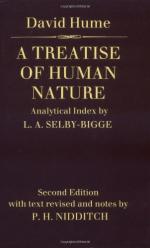When any object is presented to us, it immediately conveys to the mind a lively idea of that object, which is usually found to attend it; and this determination of the mind forms the necessary connexion of these objects. But when we change the point of view, from the objects to the perceptions; in that case the impression is to be considered as the cause, and the lively idea as the effect; and their necessary connexion is that new determination, which we feel to pass from the idea of the one to that of the other. The uniting principle among our internal perceptions is as unintelligible as that among external objects, and is not known to us any other way than by experience. Now the nature and effects of experience have been already sufficiently examined and explained. It never gives us any insight into the internal structure or operating principle of objects, but only accustoms the mind to pass from one to another.
It is now time to collect all the different parts of this reasoning, and by joining them together form an exact definition of the relation of cause and effect, which makes the subject of the present enquiry. This order would not have been excusable, of first examining our inference from the relation before we had explained the relation itself, had it been possible to proceed in a different method. But as the nature of the relation depends so much on that of the inference, we have been obliged to advance in this seemingly preposterous manner, and make use of terms before we were able exactly to define them, or fix their meaning. We shall now correct this fault by giving a precise definition of cause and effect.
There may two definitions be given of this relation, which are only different, by their presenting a different view of the same object, and making us consider it either as a philosophical or as a natural relation; either as a comparison of two ideas, or as an association betwixt them. We may define a cause to be An object precedent and contiguous to another, and where all the objects resembling the former are placed in like relations of precedency and contiguity to those objects that resemble the latter. I If this definition be esteemed defective, because drawn from objects foreign to the cause, we may substitute this other definition in its place, viz. A cause is an object precedent and contiguous to another, and so united with it, that the idea, of the one determines the mind to form the idea of the other, and the impression of the one to form a more lively idea of the other. 2 should this definition also be rejected for the same reason, I know no other remedy, than that the persons, who express this delicacy, should substitute a juster definition in its place. But for my part I must own my incapacity for such an undertaking. When I examine with the utmost accuracy those objects, which are commonly denominated causes and effects, I find, in considering a single instance, that the one object is precedent and contiguous




